Design and construction
Rover was designed in 1872 by Edward Reed, the Chief Constructor of the Navy, [1] as an improved version of the Volage-class corvettes. [2] She displaced 3,462 long tons (3,518 t) tons, nearly 400 long tons (410 t) larger than the older ships. The ship was 280 feet (85.3 m) long between perpendiculars and had a beam of 43 feet 6 inches (13.3 m). Forward the ship had a draught of 17 feet 6 inches (5.3 m), but aft she drew 22 ft 7 in (6.9 m). Her iron hull was covered by a 3-inch (76 mm) layer of oak that was sheathed with zinc from the waterline down to prevent biofouling. [1] Watertight transverse bulkheads subdivided the hull. [2] Her crew consisted of 315 officers and ratings. [1]
The ship had one three-cylinder horizontal compound-expansion steam engine made by Ravenhill, Eastons & Co., driving a single 21-foot (6.4 m) propeller. Ten cylindrical boilers provided steam to the engine at a working pressure of 70 psi (483 kPa ; 5 kgf/cm2 ). The engine produced a total of 4,964 indicated horsepower (3,702 kW) which gave Rover a maximum speed of 14.5 knots (26.9 km/h; 16.7 mph). The ship carried 420 long tons (430 t) of coal, enough to steam 1,840 nautical miles (3,410 km; 2,120 mi) at 10 knots (19 km/h; 12 mph). [1] [Note 1]
Rover was ship rigged and had a sail area of 17,863 square feet (1,660 m2). The ship was an indifferent sailor and her best speed under sail alone was only 11 knots (20 km/h; 13 mph). Ballard believes that one cause of her poor performance under sail was due to the drag of her uneven fore-and-aft trim. Her propeller could be hoisted up into the stern of the ship to reduce drag while under sail. [3]
The ship was initially armed with a mix of 7-inch and 64-pounder 64 cwt [Note 2] rifled muzzle-loading guns. All sixteen 64-pounders were mounted on the broadside while the two 7-inch (178 mm) guns were mounted underneath the forecastle and poop deck as chase guns. [5] In 1880, the ship was rearmed with 14 BL 6-inch 80-pounder breech-loading guns. One gun each was mounted at the bow and stern as chase guns while the remainder were broadside guns. Two carriages for 14-inch (356 mm) torpedoes were added as well. [1]
Rover was laid down at the yards of the Thames Ironworks and Shipbuilding Company at Leamouth, London in 1872. She was launched on 12 August 1874 and completed on 21 September 1875 [1] [6] at a total cost of £169,739. Her hull cost £104,718 and her machinery £65,021. [1]
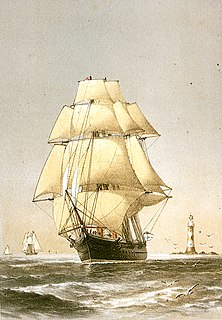
HMS Active was a Volage-class corvette built for the Royal Navy in the late 1860s. Launched in 1869, she entered service in 1873, and was the Commodore's ship on the Cape of Good Hope and West Africa Station. Her crew served ashore in both the Third Anglo-Ashanti and Zulu Wars. From 1885 to 1898, the ship was the flagship of the Training Squadron. Active was sold for scrap in 1906.

HMS Penelope was a central-battery ironclad built for the Royal Navy in the late 1860s and was rated as an armoured corvette. She was designed for inshore work with a shallow draught, and this severely compromised her performance under sail. Completed in 1868, the ship spent the next year with the Channel Fleet before she was assigned to the First Reserve Squadron in 1869 and became the coast guard ship for Harwich until 1887. Penelope was mobilised as tensions with Russia rose during the Russo-Turkish War of 1877–78 and participated in the Bombardment of Alexandria during the Anglo-Egyptian War of 1882. The ship became a receiving ship in South Africa in 1888 and then a prison hulk in 1897. She was sold for scrap in 1912.

HMS Inconstant was an unarmored, iron-hulled, screw frigate built for the Royal Navy in the late 1860s. Upon completion in 1869, she was the fastest warship in the world and was assigned to the Channel Squadron. Two years later the ship was transferred to the Detached Squadron for a brief time before she was paid off into reserve in 1872. Inconstant was recommissioned in 1880 for service with the Flying Squadron that circumnavigated the world in 1880–82. On the return voyage, the ship was diverted to Egypt during the Anglo-Egyptian War of 1882 and played a minor role supporting operations ashore. She was reduced to reserve again after her return and was served as an accommodation ship in 1897. Inconstant was hulked in 1904 and became a training ship in 1906. She continued in that role, under a variety of names, until she was sold for scrap in 1955 and subsequently broken up, the second-to-last surviving Pembroke-built warship in existence.
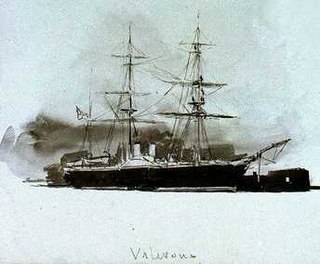
HMS Valorous was one of two 16-gun, steam-powered Magicienne-class second-class paddle frigates built for the Royal Navy in the 1850s. Commissioned in 1853 she played a small role in the Crimean War of 1854–1855 and was sold for scrap in 1891.
HMS Centurion was a 80-gun second rate Vanguard-class ship of the line built for the Royal Navy in the 1840s.
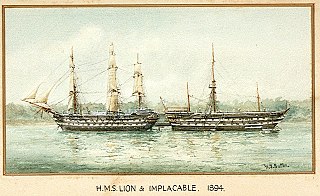
HMS Lion was a 80-gun second rate Vanguard-class ship of the line built for the Royal Navy in the 1840s. She was fitted with steam propulsion in 1858–1859. In 1871 Lion was converted into a training ship at HM Dockyard, Devonport. The ship was sold for scrap in 1905.

HMS Colossus was a 80-gun second rate Vanguard-class ship of the line built for the Royal Navy in the 1840s. The ship was fitted with steam propulsion in 1854–1855, and was sold for scrap in 1867.

The Camelion class was a class of screw-driven sloops of wood construction, designed by Isaac Watts and operated by the Royal Navy. Eight ships of the class were built from 1858 to 1866 with another eight cancelled. They were initially rated as second-class sloops, but were later reclassified as corvettes.

HMS Druid was a Briton-class wooden screw corvette built for the Royal Navy in the late 1860s. She spent her service life overseas on the Cape of Good Hope and North America and West Indies Stations and was sold for scrap in 1886.

The Volage class was a group of two screw corvettes built for the Royal Navy in the late 1860s. Both ships spent the bulk of their active service abroad. Volage spent most of her first commission assigned to the Detached or Flying Squadron circumnavigating the world and then carried a party of astronomers to the Kerguelen Islands to observe the Transit of Venus in 1874. The ship was then assigned as the senior officer's ship in South American waters until she was transferred to the Training Squadron during the 1880s.

HMS Volage was a Volage-class corvette built for the Royal Navy in the late 1860s. She spent most of her first commission assigned to the Flying Squadron circumnavigating the world and later carried a party of astronomers to the Kerguelen Islands to observe the transit of Venus in 1874. The ship was then assigned as the senior officer's ship in South American waters until she was transferred to the Training Squadron during the 1880s. Volage was paid off in 1899 and sold for scrap in 1904.
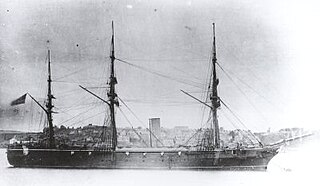
HMS Amethyst was the lead ship of the Amethyst-class corvettes built for the Royal Navy in the early 1870s. She participated in the Third Anglo-Ashanti War in 1873 before serving as the senior officer's ship for the South American side of the South Atlantic. The ship was transferred to the Pacific Station in 1875 and fought in the Battle of Pacocha against the rebellious Peruvian ironclad warship Huáscar two years later. This made her the only British wooden sailing ship ever to fight an armoured opponent. After a lengthy refit, Amethyst again served as the senior officer's ship on the South American station from 1882 to 1885. She was sold for scrap two years later.
The Briton class was a group of three wooden screw corvettes built for the Royal Navy in the late 1860s. All three ships of the class only served overseas during their brief service lives. Between them, they were assigned to the China, East Indies, African, North American, and the Pacific Stations. All three were regarded as obsolete 15 years after they were completed, and they were sold in 1886–87.
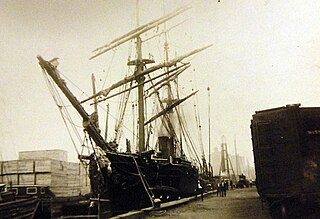
HMS Pelican was an Osprey-class sloop built for the Royal Navy in the mid-1870s. She was launched in 1877 and was sold to the Hudson's Bay Company in 1901. She was scuttled in 1953.

HMS Wild Swan was an Osprey-class sloop built for the Royal Navy in the mid-1870s. She was launched in 1877 and became a base ship in 1904, being renamed Clyde. She was renamed Columbine in 1913 and was sold for breaking in 1920.

The Beacon-class gunvessels were a class of composite gunboats built for the Royal Navy in the late 1860s. They were the first warships of the Royal Navy expressly designed to use the engines of an older class of ships with a different hull shape. They were generally deployed overseas to the China, East Indies, West Africa, Pacific, North America and West Indies Stations. In addition to showing the flag, the ships fought pirates and suppressed the slave trade in East and West Africa. As their engines wore out in the mid-1880s, they were mostly retired and scrapped by the end of the decade. A few survived into the early 1900s as they were modified for harbour service before being sold or scrapped.
The Frolic-class gunvessels were a class of composite gunboats built for the Royal Navy in the early 1870s. They were generally deployed overseas to the East Indies, West Africa, and China Stations. In addition to showing the flag, the ships fought pirates and suppressed the slave trade in East Africa. They were placed in reserve in the mid-1880s, and two of them were sold for scrap by the end of the decade. The other pair survived for longer as they were either modified for harbour service or became a training ship before being sold or scrapped. The last survivor, Ready, was used in support of William Beebe's expedition in his bathysphere in 1930 off Bermuda.

HMS Magicienne was the lead ship of her class of two 16-gun, steam-powered second-class paddle frigates built for the Royal Navy in the 1850s. Commissioned in 1853 she played a small role in the Crimean War of 1854–1855 and was sold for scrap in 1866.

The Banterer-class gunboat was a class of eleven gunboats mounting two 6-inch and two 4-inch guns, built for the Royal Navy between 1880 and 1892.

The Albacore-class gunboat, also known as "Crimean gunboat", was a class of 98 gunboats built for the Royal Navy in 1855 and 1856 for use in the 1853-1856 Crimean War. The design of the class, by W. H. Walker, was approved on 18 April 1855. The first vessels were ordered the same day, and 48 were on order by July; a second batch, which included Surly, were ordered in early October.
















